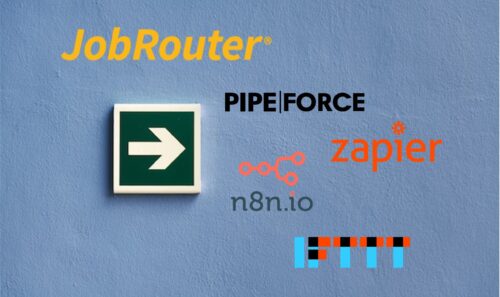
Secure data exchange: The 5 most important points
Secure data exchange requires the right tools – without reliable protection of sensitive information, companies risk not only heavy fines, but also the leakage of critical information to competitors and loss of reputation with customers and partners. To prevent this, five critical success points have emerged, which we present to you in this article.
What does “secure data exchange” mean?
To begin with, the topic of “secure data exchange” is often understood to cover a variety of issues. For us, secure data exchange means that a company can exchange data and documents with external parties (e.g. customers or suppliers) without unauthorized third parties being able to access, view or manipulate this information.
The 5 most important points in secure data exchange – overview:
- Central solutions for secure data exchange
- Access for all employees
- Ease of use and integration
- Traceability and documentation
- Automation of transfer processes
1. secure data exchange with central solutions
Regardless of which technical solutions are ultimately used in the company, they should be selected and implemented by a central body. In most cases, IT is the right department here, which can evaluate and implement the solutions from a technical perspective. The minimum technical requirement here should be transport encryption with SSL or TLS as well as encryption of the data on the respective server with AES-256.
If one considers the business processes in the context of which information requiring protection is exchanged, at least the three scenarios of ad hoc sending, sharing and receiving should be covered. Secure ad hoc dispatch is about sending a message incl. Attachment to be securely transmitted to a recipient. Options for this include sending a message via encrypted email. Secure information sharing and receiving, on the other hand, is about placing a file in a secure location and giving the recipient read or write permissions to that file. This is often done with cloud folders, which are shared with the external party. Files can then also be uploaded to these and checked for viruses, for example, before they enter the company network.
2. access for all employees
Widespread distribution and easy access to secure solutions across enterprises has emerged as another critical success factor for data security. According to a 2020 study, an average of 70% of all employees in companies have access to sensitive or personal data. This makes it crucial that solutions for secure data exchange are not only available to a small group or special departments, but to all employees in the company. When selecting and licensing solutions, care should therefore be taken to ensure that they can be made available to all employees with a computer workstation across all departments and rolled out to them by “default”.
3. ease of use and integration
Usability is crucial so that the solutions provided can be used by all employees in the company with as little training as possible. Acceptance by employees and external parties is also critically dependent on how easy a solution is to deploy. The additional effort required for secure delivery should be close to zero or, ideally, even less than insecure delivery by e-mail.
To achieve this, two factors are particularly important: intuitive use and integration with existing systems. The intuitive use of the solutions means that training requirements are minimized. Integration into existing systems (e.g. via an Outlook add-in) allows employees to work in their familiar working environment. This reduces complexity for the employee and significantly increases acceptance.
4. traceability and documentation
No security without control! Another significant success factor for data security is IT’s ability to track what information is being shared with external parties. In this context, it is crucial that the sending and receiving of files is recorded without gaps and documented in an audit-proof manner. Furthermore, it must be completely transparent and traceable at the push of a button which information leaves the company, to which persons it is shared, with which security level a document was transmitted and which access options exist at the current time.
Based on this information, it is possible to obtain audit-proof documentation of data exchange with external parties, which is often the only way to protect your company’s interests in the event of data loss or legal disputes.
From a legal and technical perspective, the internal exchange of information (e.g., via Office 365 or file servers) must be distinguished from external exchange. To reduce complexity, it is recommended to clearly separate these two fields and not to mix the data basis. Furthermore, when exchanging data with external parties, there are special challenges for simple and secure authentication of the recipients, which can be solved much more easily when exchanging data internally.
5. automation of transfer processes
The success factors 1 to 4 described above aim to provide suitable solutions within the company and to make the use of these solutions comprehensible. The use of the solutions by employees can be controlled via compliance and system specifications and supported by very good usability. Experience has shown that these measures already prevent the most common risks of data loss and significantly improve data security.
However, if a company wants to ensure with one hundred percent certainty that certain information is always transmitted with a previously defined level of security, it is necessary to map these cases using an automated workflow. Examples include the automated secure dispatch of invoices and contracts directly after they have been created, or the receipt and processing of personnel, application and customer data via corresponding digital workflows. Other positive side effects of automated workflows are usually the significantly reduced manual effort and faster turnaround times.
Secure data exchange – checklist:
To help you assess your current situation, we have compiled a brief checklist below. From our experience, you have an acute need for action if two or more of the following five points are answered with “No”.
1. do you have central solutions in place within the company that can be used to map encrypted ad hoc sending, secure file sharing and receiving?
2. do at least 80% of your employees with a PC workstation have a license and direct access to these solutions?
3. does the use of the solutions require a maximum of 10% additional effort for secure delivery compared to standard email?
4. do you have the possibility in the company to make transparent at the push of a button which information requiring protection left the company the day before and which information is released to external parties at the current time?
5. with your currently deployed solutions, do you have the possibility to control by a central default that a certain document (e.g. a customer contract) is always sent with an increased security level?
Answered “no” to more than one question? Then you should act!
As experts in secure and traceable data exchange, we will be happy to provide you with non-binding advice on your individual needs and show you how we have solved comparable problems with our customers. To do so, simply contact us using the form below:






